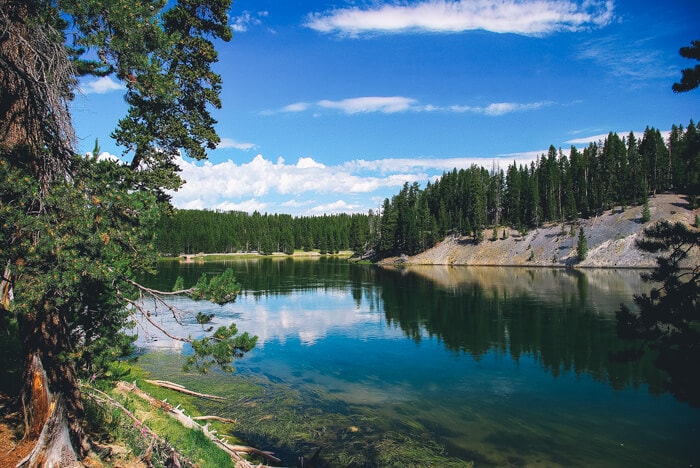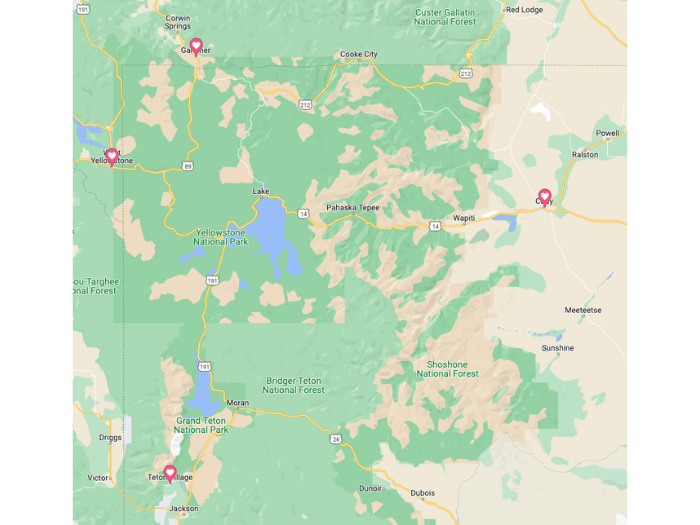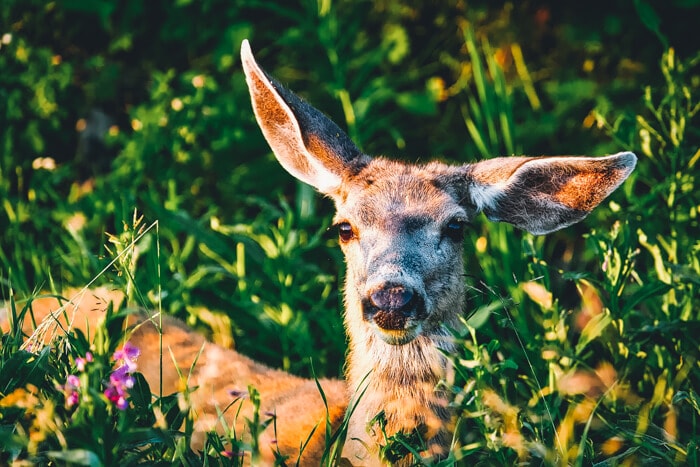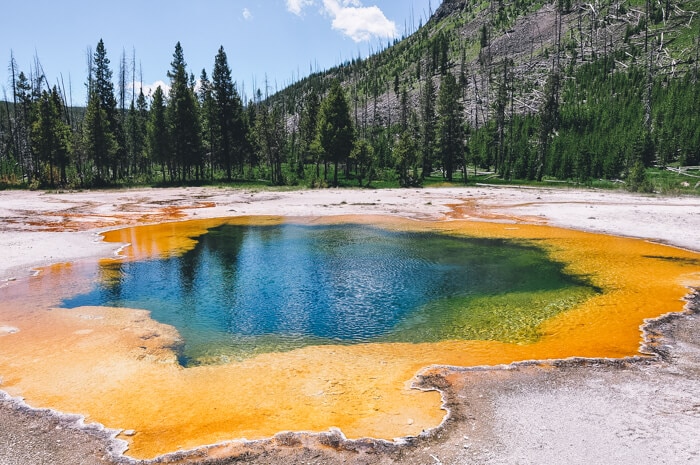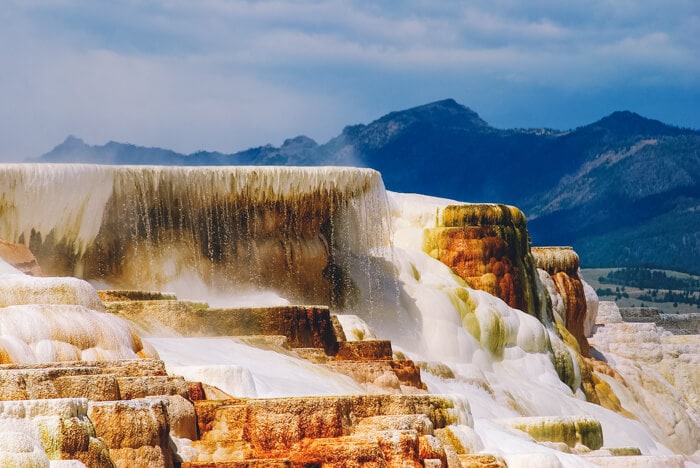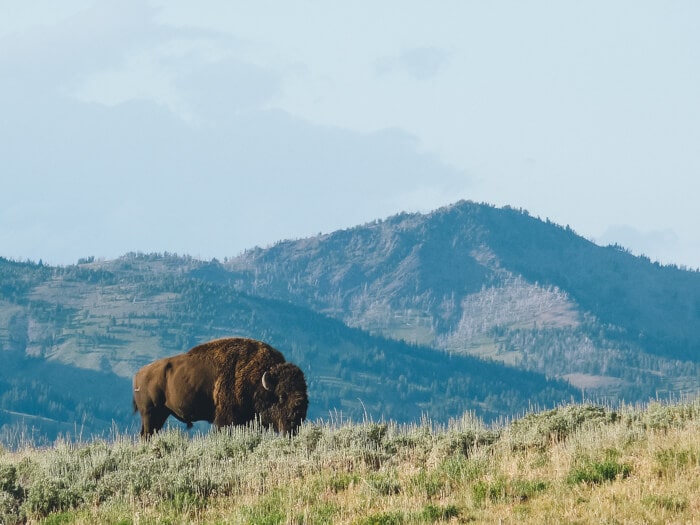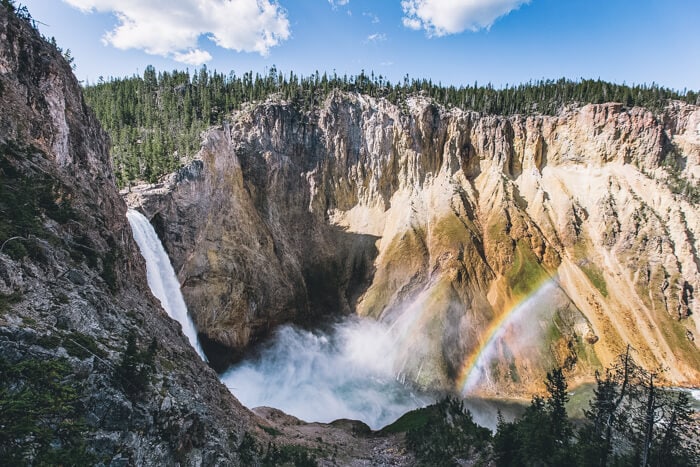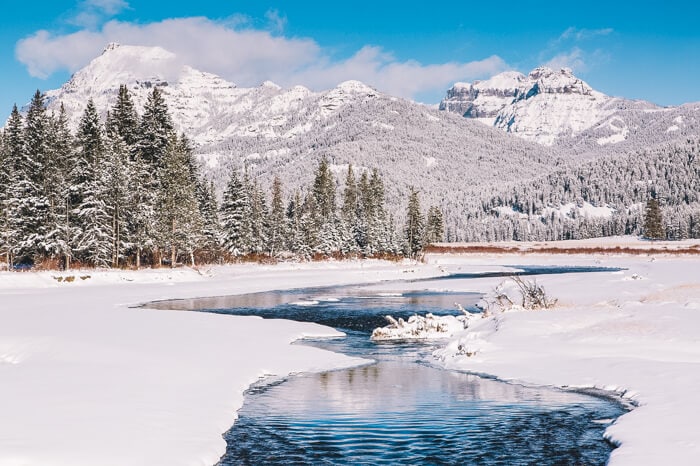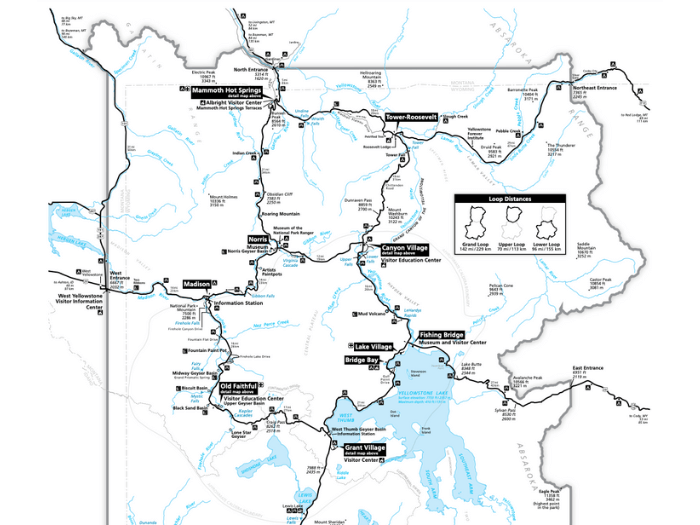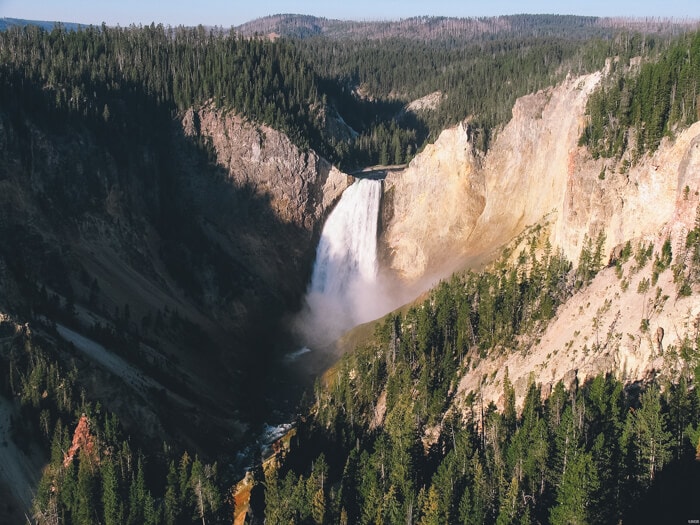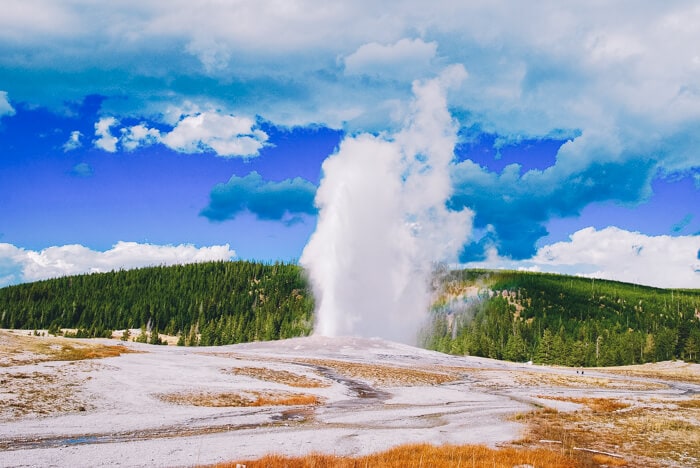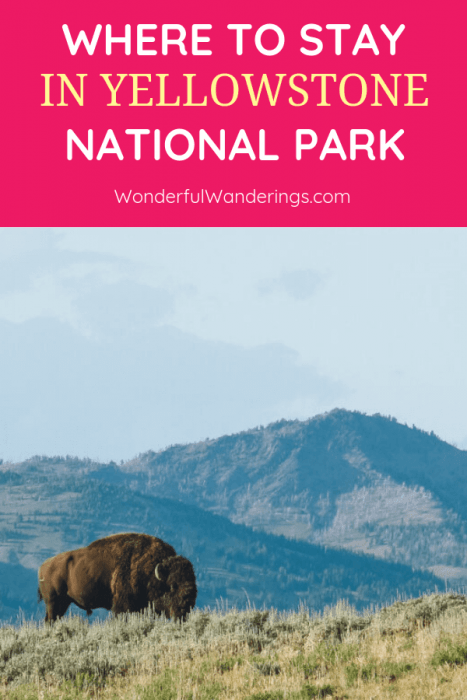Yellowstone National Park in the United States is something we believe every person should see at least once. Opened by President Ulysses S. Grant on March 1 1872, Yellowstone is the world’s first national park. There’s tso much to see, including the geyser Old Faithful, the Grand Canyon of the Yellowstone, and the Yellowstone lake, river, and waterfalls. Not to mention Artists’ Point, a beautiful spot overlooking it all!
A day is simply too short for this place, so you need to know where to stay when visiting Yellowstone National Park. There are lots of accommodations in Yellowstone: inns, hotels, Airbnbs, tent camping, RV camping, and Yellowstone National Park cabins.
In this article, Bill Widmer discusses all the options for the best lodging inside Yellowstone National Park and gives us a few tips on how to have the best stay possible. Bill and his fiance Kayla run The Wandering RV, a site about RV travel and lifestyle. Follow them on Pinterest to learn more about camper traveling!
And now, let’s dive in!
Planning your trip to Yellowstone National Park
Yellowstone National Park is the second largest national park in the United States and covers 2 million acres of land. No wonder you are confused about where to stay!
Before we discuss five Yellowstone lodging options, you have to decide if you want to stay inside Yellowstone or outside the park.
If you stay inside the park, you’ll need to book your stay far in advance as the park lodges sell out far in advance. There are nine official lodges inside the park itself, that have approximately 2,000 beds, we’ll go into detail about each of these lodges later in the post.
If you’re staying outside the park, you have four options when looking for the best lodging near Yellowstone:
- The West Entrance, which is near Geyser Basins
- The North Entrance or Northeast Entrance, which is near Gardiner and Wildlife Watching
- The East Entrance, which is near Yellowstone Lake, the Giant Waterfalls and the Buffalo Bill History exhibit and the town Cody
- The South Entrance, which is next door to Grand Teton and Jackson Hole
This map shows the four areas you can find accommodation if you’re considering staying outside the park. The map also gives you an idea of vast area the park covers.
Where to stay when visiting Yellowstone National Park: 6 accommodation types to try
If you’re having trouble deciding where to stay when going to Yellowstone, check out Yellowstone’s official trip planning guide. They have loads of tips on what attractions to see and where to stay.
1. Book hotels inside Yellowstone National Park
If you want to see the incredible outdoors while still having all the comforts of home, there are plenty of beautiful inns and hotels for your Yellowstone national park stay inside the park itself.
There are nine hotels inside Yellowstone alone, plus dozens more in the surrounding area. So rather than recommending a specific few, we’ll provide some resources and the pros and cons of this method of staying in the park.
Here are your options for hotel or cabin rentals inside the Yellowstone National Park:
- Old Faithful Inn – From the Old Faithful Inn, you can see the Old Faithful geyser right from the deck and some of the rooms. The building itself is a work of art dating back to 1914. There are three lodges at the Old Faithful Inn and it’s one of the United States’ last log hotels. It’s possibly one of the best hotels inside Yellowstone National Park.
- Lake Yellowstone Hotel & Cabins – One of the best lodging options in Yellowstone, this historic landmark has recently undergone a full interior multi-million dollar renovation! The hotel has a deli, a dining room and a canteen where you can enjoy delicious food with views over the lake. The hotel has easy access to the Fishing Bridge Museum.
- Mammoth Hot Springs Hotel & Cabins – Technically this falls under “cabins” as well, but we put it here. Accommodations range from one-bedroom suites to budget cabins. The hotel is in the north of the park and is a short stroll from Fort Yellowstone which is an army fort from 1891, you can take guided tours here throughout the year.
- Canyon Village – this is the largest lodging in Yellowstone, with more than 500 rooms and cabins to rent. It’s on the east side of the park near the Grand Canyon of the Yellowstone River. Keep in mind the lodging is only on from mid-May to early October. The complex offers plenty of options for eating, including it’s own ice creamery! You can choose your accommodation in Canyon village from the following options: Suites, deluxe porch new lodge room, deluxe new lodge room, deluxe lodge room, standard lodge room, western cabins. Some of the cabins are pet friendly.
- Grant Village – this village of lodges is on the west side of the park, near the Yellowstone lake, there are 6 buildings in total, each with 50 rooms. The lodging village has a lakeside restaurant, a lounge and gift shop. This lodging at Yellowstone is a great option if you want to also visit Grand Tenton National Park.
Pros of hotels & inns:
- Lots of comfort
- Often in great locations
- Easy to access
- You have great viwes
- You don’t need to travel far to start a hike
- Food and drinks are available at the hotel restaurants
Cons of hotels & inns:
- Can be pricey
- They book fast (you usually need to book at least 3-4 months in advance, but some places have bookings up to a year early!)
- Many of the hotels don’t have the best lodgings (be sure to read reviews thoroughly before booking)
- You lose time driving if you need to return to the same hotel every night
- If you’re going for the experience of being immersed in nature, staying at a hotel may not be the best option for you
2. Yellowstone cabins
Staying in a log cabin, you still get a shower and a kitchen but are usually closer to the hiking and scenery. Plus, the cool thing about log cabins is that you can either stay in a very basic one or stay in a luxury cabin. Some of the best Yellowstone park cabins for rent include:
- Lake Lodge Cabins – Located in a great area by the Yellowstone lake, these cabins offer three room types (Western Cabins, Frontier Cabins, and Pioneer Cabins). There are nature trails on the property with excellent views of the lake and mountains. The starting price to rent a cabin is $320.
- Canyon Lodge & Cabins – Located near the Grand Canyon of Yellowstone, the Canyon Lodge & Cabins are budget-friendly and clean, but only have the bare minimum.The standard room has 1 queen bed and have a bathroom with a shower. Although they are in the Canyon Village, there aren’t any views of the canyon from the cabins. But if you want to be in among the action of Canyon Village and visit the Grand Canyon of Yellowstone, it’s a great option. Prices to rent a cabin start at $264.
- Roosevelt Lodge Cabins – Built in the 1920s, these cabins area near the Tower Fall area of Yellowstone and are near a camp that Theodore Roosevelt used. the rocking chairs on the front porches of the cabins add some nostalgia to the experience. You can opt for horse riding exercuisons on the trails out the front of the cabins or join the Old West Dinner Cookout. Choose from Frontier Cabins which have 2 double beds with bathrooms and Roughrider Cabins which have between 1 and 3 double beds but no bathroom. They have a wood burning stove for warmth and communal bathrooms in the central cabin area. These cabins are only open between June and September.
Pros of lodge Yellowstone cabin rentals inside the park:
- Closer to nature and scenery
- Beautiful views right outside your front door
- More authentic experience
- More of a “camping” feel than hotels or inns
- You still have the luxury of a comfy bed and the option for private bathroom
- Less expensive than hotels
Cons of lodge cabins inside the park:
- Can be pricey
- They book up pretty fast
- They’re only available during summer
- You lose time driving if you need to return to the same cabin every night
3. RV camping
Our personal favorite way to stay in Yellowstone is in an RV! Motorhomes, travel trailers, campervans — you name it, they’re all great choices. With an RV you can stay in multiple campsites all across the park throughout your vacation – there are 12 campgrounds in Yellowstone. That way, you can see more of everything without spending as much time driving back to your cabin or hotel!
Don’t own an RV? No problem if you’re thinking of renting an RV for Yellowstone National Park, check out these RV rental options to stay in RV parks. It’s much cheaper than purchasing your own, and you can even have the RV owner drop it off and set it up right at your campsite.
If you’ve never traveled with an RV before, read Sofie’s article about her first RV trip. She loved it!
Many of the options inside the park are cabin and RV spots, so you can park up your van for the night. Remeber, if you choose to camp in the park, you need to stay in a designated camping zone and not a parking lot or picnic area.
There are are 12 campgrounds in the park and you need to resevere your space in advance. You can see the areas of the campsites on this map:
There are a dozen options for sleeping in an RV in Yellowstone. Below you can learn a little more about each camping ground.
These RV campsites are reservable through Yellowstone National Park Lodges:
- Bridge Bay Campground which is near Yellowstone Lake and has an elevation of 2,377m.
- Canyon Campground is in the pine forget at Canyon Village at 2,408m high. There are stores and restaurants in nearby Canyon Village.
- Fishing Bridge RV Park is 2,377m high and near the Yellowstone River. This is the only campground that has water, sewer and electrical hook ups for your RV. this camp site costs $83 a night + taxes. Tents are not allowed at this campsite because it’s an area the grizzly bears frequent.
- Grant Village is at the south side of the Yellowstone Lake, and is one of the larger camp grounds. It’s 2,377m high.
- Madison Campground is east of West Yellowstone and north of Old Faithful and is at 2,073m elevation. In the early Autumn, you can hear elk from this campsite.
These campsites are reservable through Recreation.gov:
- Indian Creek Campground is 8 miles south of Mammoth Hot Springs and 2,,225m elevation. It’s a great place to stay if you want easy access to fishing. This campsite is further away from the main road, so the camping experience is a little wilder.
- Lewis Lake Campground is a short walk from Lewis Lake in the south of the park. You can canoe, kayak or rent a motor boat to drive on the lake. The campground is 2,377m high.
- Mammoth Campground is open all year, and is just south of the parks’s north entrance. It’s 1,890m high and is among the fir and juniper trees and close to Mammoth Hot Spr¡ings. Elk and byson regularly pass through the camp site.
- Norris Campground is a great choice if you want to see the park’s wildlife. The camp is also close to the Museum of the National Park Ranger and the Norris Geyser Basin Museum.
- Pebble Creek Campground is 2,103m high and is near the northeast park entrance. This campground is one of the most scenic options and has easy access to hiking trails, along with views of the Absaroka Mountains.
- Slough Creek Campground is better for small RVs as it’s at the end of a dirt road. It’s a quite campsite with great views of the stars and lots of hiking trails nearby.
- Tower Fall Campground is close to Roosevelt Lodge and Tower General Stors on the north side of the park. It’s also close to the Lamar Valley which has great hiking trails.
All the RV parking sites cost between $20 – $35 a night and they have different maximum lengths for your vehicle. Check the max length of the campsite you plan to park at before booking!
Keep in mind that in most cases, the camp sites are closed mid-October through April.
Pros of RV parks:
- Typically cheaper than any other method besides tent camping
- You can stay at multiple sites to see the whole park without lots of driving back and forth
- You still get your own shower, toilet, and kitchen
Cons to RV Parks:
- Unless you get a small RV, driving your rig around the park can be stressful
- Campgrounds book up fast during peak season
- Only one of the campsite has electricity
Pro Tip: If you’re going to stay in a camper, be sure to either tow/drive a separate car if you’re in a motorhome, or have a vehicle you can unhook from your trailer to travel the park. The roads are very hilly, and driving a big RV on them is not a good idea.
4. Tent camping
If you’re more of an adventurous type, why not sleep in a tent hotel in Yellowstone?! Tent camping (or glamping) is my second choice next to RVing (but I also love being outdoors and don’t mind public restrooms for a short while).
Of the campgrounds in Yellowstone mentioned above all but one accommodate tent camping in addition to RVs. The only exception is Fishing Bridge RV Park which only accommodates RVS (due to the grizzly bears who frequent the area!). All the camping options in the park have access to public toilets.
If your trip to Yellowstone is from abroad and you didn’t pack your camping gear, don’t worry, there are plenty of companies that rent tents and camping supplies, just search for “camping rentals Yellowstone”.
Pros of tent camping:
- It’s the closest you can get to sleeping in nature
- It’s the cheapest option to stay in the park
- You can rent sites at multiple campgrounds to stay around the whole park rather than traveling back to your hotel or inn
Cons of tent camping:
- You’re sleeping on the ground
- In summer it can be extremely hot
- You have to use public restrooms and showers
- You may have close wildlife encounters
- No kitchen or normal comforts of home
Pro Tip: To have a more enjoyable Yellowstone camping experience, be sure to bring bug spray, and an air mattress to sleep on. Also don’t leave your food supplies outside as it can attract unwanted visits from wild animals. Many of the campgrounds have food storage lockers to keep your snacks safe!
5. Rental homes and Airbnb in Yellowstone
The fifth option for accommodations in Yellowstone is peer-to-peer rentals like Airbnb. By booking Airbnbs in Yellowstone and staying at someone’s home, you can get some very unique experiences and stay at locations where you won’t always find other types of lodging.
If you found this post helpful, please consider booking your next Airbnb through my link. I’ll earn a small commission while the price for you stays exactly the same. Income like this helps me travel independently and create new content.
There aren’t actually any Airbnbs for rent inside the park, but you can find plenty of great Yellowstone National Park rentals outside the park. Here are a few examples of unique accommodation for rent near Yellowstone:
- Yellowstone River Lodge with Kayaks and Mountain Views This 6 bedroom lodge is 9km from Badger Basin, to the east of the park.
- Beyond Yellowstone Lodge is a 3 bedroom, pet friendly rental with great views and a hottub. It’s on the east side of the park.
- Explorer Cabins at Yellowstone are just 1km from the park’s west entrance. There are different cabin sizes – 1 bed or two bed, and all cabins have access to an indoor heated pool. You are also within walking distance to lots of restaurants.
Pros of peer-to-peer rentals:
- A very wide variety of options
- Some places are much less expensive than hotels
- More privacy than hotels
- You’ll have a kitchen so can make your own meals and not have to rely on restaurants
- Can find truly unique experiences (beautiful homes with fireplaces, indoor pools, etc.)
Cons of peer-to-peer rentals:
- There’s no real quality standard (be sure to read reviews thoroughly before booking!)
- Some rentals aren’t conveniently located which means you need to drive a long way to explore the park
Pro Tip: I recommend passing on any Airbnb’s that allow smoking! Check out Sofie’s step-by-step guide on how to use Airbnb for more tips.
6. Stay in a hotel outside Yellowstone
If you prefer the luxury of a hotel but didn’t book in time to get a spot inside the park, here is a selection of the best hotels at Yellowstone National Park by location:
North entrance
Yellowstone Basin Inn offers great views, exceptional hospitality, cozy rooms, delicious breakfasts and just a short drive to the north entrance of the park.
South entrance
If you also want to make the Grand Teton National Park part of your visit to Yellowstone, check out Jackson Lake Lodge which is one of the nicer accommodations near Yellowstone National Park. The lodge offers exceptional views of the Teton mountains, as well as sunsets. There are several restaurants onsite and it’s 35km from Yellowstone’s south entrance.
West Entrance
The options around the west entrance are the most plentiful but if you’re looking for a cozy, well maintained hotel, the Golden Stone Inn is just 1.6km from the West entrance, offers charm, comfort and quality, onsite restaurants, beautiful grounds and an outdoor fireplace.
East entrance
SpringHill Suites Island Park is a top rated hotel hotel near Yellowstone National Park. It’s only a short drive to the East entrance, has top facilities, generous breakfast which you can eat on the scenic terrace by the river, and even an outdoor jacuzzi.
Pros of hotels outside the park:
- It’s a great option if you need to book last minute
- Cheaper than the hotels inside the park
- Often have great views and access to nature
- Many of the hotels are conveniently located in towns with lots of restaurants and grocery stores
Cons of hotels outside the park:
- You’re going to spend a lot of time driving
- You don’t get the full Yellowstone experience that staying inside the park offers
Pro Tip:
Try booking an accommodation with free cancellation, that way if your plans change (or a spot becomes available at a lodge inside the park) you won’t lose anything. You can often find availability at lodges inside the park a few weeks before your planned date as people cancel their bookings.
How to have the best Yellowstone experience (7 travel tips)
Planning your trip to Yellowstone National Park is no small matter. You’ve got four quadrants: North Yellowstone, West Yellowstone, East Yellowstone, and South Yellowstone. Within those sections of Yellowstone National Park, you’ve got activities and sights including:
- Mammoth hot springs
- Boiling river hot springs
- Yellowstone’s Old Faithful Geyser Basin
- The Grand Canyon of Yellowstone Park
- Hiking in the rocky mountains
- Lamma Valley
- Fairy Falls
- Tower Fall
- Hayden Valley
- Animal watching (birds, moose, buffalo, deer, bear, and more)
- Grand Tetons
And that’s just scratching the surface. So to help you get the most out of your trip to Yellowstone National Park, here are seven travel tips:
1. Stay in at least two places (one in North Yellowstone, one in South Yellowstone)
There are two loops in Yellowstone National Park: North and South. (You also have the East Yellowstone and West Yellowstone entrances, but you can hit them within the north and south loops.)
Yellowstone is massive. And the traffic can be brutal, especially during peak seasons and whenever animals are near the road (people love to stop and get pictures of them). So to avoid more driving and have more time to actually enjoy the experience, try to book lodging options so you spend one half of your trip near the north loop inside the park and one half of your trip near the south loop.
2. Stay inside the park, if possible
Speaking of traffic: while there are plenty of accommodation options outside the park and it may be cheaper, Yellowstone is nearly 3,500 square miles (and larger than Rhode Island and Delaware combined!). In other words, you won’t want to drive outside the park after spending all day sight-seeing, hiking, and doing everything else people do there. Staying inside the park is preferred. But it’s ultimately up to you.
3. Book your trip very far in advance
Like I said before, Yellowstone can be booked up to a year in advance. If you wait until the last minute, you might not get in. That you can now also stay at Airbnbs helps a lot, but I still recommend you book something sooner rather than later.
Campsite and in park lodge reservations open a year in advance on May 1, so if you want to book for 2024, you’ll need to get booking on May 1 2023. You don’t need an entry ticket to get inside the park and the gates are open 24hours a day.
4. Consider going in off-season
Be prepared for crowds when visiting Yellowstone! Summer season is a particularly crowded time at any national park, but even more so at Yellowstone. The best time to visit is late-May/early-June for great views and weather without quite as much traffic. If you’re really adventurous, they also offer snow lodge and cabins for winter excursions.
5. Make dinner reservations when you book your accommodation
This is often overlooked, but restaurants fill up just as fast and have just as much demand as the hotels in Yellowstone so make sure you book them at the same time. In peak season, this park is crowded!
6. Realize that the available technology there is limited
Yellowstone’s accommodation options usually do not have TVs. The cell service is 3G and not all lodgings have wi-fi. In other words, bring some good books and be prepared for some digital detoxing. If you need to stay online, it’s better to check accomodation options outside the park.
7. Check for road closures in advance
Driving distances are long in and around the park, so you want to make sure the route you planned is open or you could end up taking a big detour.
You can’t predict the natural world, and there are often road closures in Yellowstone. In summer 2022, there was extreme flooding in the park which led to many of the roads getting closed to visitors. To avoid disappointment, check the park’s official website on the day you plan to visit.
That’s it! I hope this post gave you a better idea of where to stay when visiting Yellowstone National Park.
PIN FOR LATER

